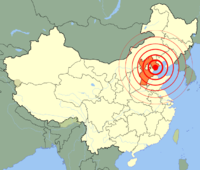
Photo from wikipedia
On July 23, 2019, a large catastrophic landslide was triggered by heavy rainfall at Jichang Town, Shuicheng County, Guizhou, China. This high-speed landslide was characterized by a short slip time,… Click to show full abstract
On July 23, 2019, a large catastrophic landslide was triggered by heavy rainfall at Jichang Town, Shuicheng County, Guizhou, China. This high-speed landslide was characterized by a short slip time, long slide distance, and great destructiveness. In less than 2 min, about 2 million m 3 of cataclastic basalt soil failed with a runout of about 1.25 km over a total vertical distance of about 465 m. The landslide destroyed 21 houses and caused 42 fatalities with 9 people missing. To understand the possible mechanisms for the high-speed and long-runout behavior of the landslide, a detailed field survey was conducted. A preliminary analysis was performed on the movement characteristics and formation mechanism of the landslide based on combining data from multitemporal optical satellite remote sensing images, aerial photography from an unmanned aerial vehicle, and InSAR. The historical remote sensing images, InSAR results, and geological monitoring data indicated no obvious deformation signs before the landslide, which implies that it occurred suddenly. The landslide was probably primarily induced by heavy rainfall, while the direct impact of road excavation was small. The terrain controls motion characteristics of the landslide and air blast effect is still visible at the leading edge of the landslide. The results of this study may provide basic data for further research on the mechanisms for landslide initiation and movement.
Journal Title: Landslides
Year Published: 2020
Link to full text (if available)
Share on Social Media: Sign Up to like & get
recommendations!